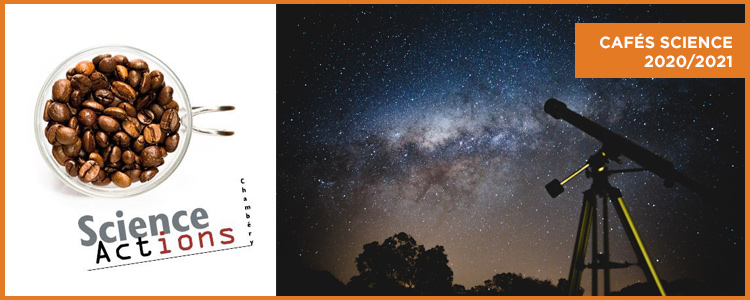Jeudi 25 février 2021 à 18h30, l’association Science-Actions vous propose d’échanger autour de l’astronomie et de l’astrophysique. Le Café science « Mystères dans le ciel » est proposé en visio-conférence (mode d’emploi).
[Visionner la webconférence en replay]
Mystères dans le ciel
L’observation du ciel (astronomie) et l’explication des phénomènes observés par la physique (astrophysique) troublent souvent notre bon sens d’êtres humains, car les ordres de grandeurs et les lois physiques mis en jeu sont extraordinairement éloignés de ce que nous connaissons dans notre vie quotidienne de bipèdes terrestres. De plus, les scientifiques ne savent pas expliquer, en tout cas avec les théories physiques d’aujourd’hui, ce qui reste des énigmes, par exemple pour n’en citer que quelques-unes :
- Qu’est-ce que l’énergie noire ?
- Quelle est cette matière « manquante » et invisible, la matière noire ?
- Où est passée la matière visible de notre quotidien (dont on appelle baryons les constituants élémentaires) que l’on devrait voir en plus grande quantité dans l’univers ?
- Pourquoi la surface du Soleil est-elle si chaude ?
- Pourquoi la surprenante antimatière n’est-elle pas aussi répandue dans l’univers que la matière que nous connaissons ?
- Pourquoi le système solaire est-il constitué de planètes aussi différentes ?
Mais les connaissances progressent et des tentatives d’explication de ces énigmes sont proposées. Par exemple, en utilisant l’enregistrement de très brèves bouffées d’ondes radio (FRB, Fast Radio Burst en anglais) provenant de l’espace, on a pu extrapoler que l’espace entre étoiles et entre galaxies contient des quantités infimes de matière (1 baryon par m3). Cette matière, qui avait échappé jusqu’à présent à nos observations à cause de sa rareté, est-elle la matière noire tant recherchée ? Et d’ailleurs, a-t-on une idée sur ce qui émet ces FRB à l’énergie phénoménale ? Très récemment, l’observatoire souterrain du Gran Sasso en Italie a signalé l’enregistrement d’un signal correspondant à une particule hypothétique extrêmement légère, l’axion, qui pourrait expliquer une partie de la matière noire manquante : découverte extraordinaire ou artefact de mesure ? Même plus près de nous, l’observation des planètes du système solaire nous révèle des phénomènes extraordinaires : ainsi la petite Cérès qui gravite autour de Jupiter présente à sa surface des volcans de glace qui laissent échapper de la saumure, à la manière de la lave des volcans terrestres.
Venez débattre sur ce sujet avec des intervenants spécialistes de ce domaine :
- Damir Buskulic, professeur à l’Université Savoie Mont Blanc, ondes gravitationnelles, laboratoire LAPP (CNRS/USMB), Annecy le Vieux
- Elisabeth Maris, présidente du club d’astronomie Céphée 73, Chambéry
- Gilles Maurin, maître de conférences à l’Université Savoie Mont Blanc, astronomie gamma, laboratoire LAPP (CNRS/USMB), Annecy le Vieux
- Pierre Salati, professeur à l’Université Savoie Mont Blanc, physicien, astrophysique, laboratoire LAPTH (CNRS/USMB), Annecy le Vieux
- Bernard Schmitt, directeur de recherche au CNRS, planétologie, Institut de Planétologie et d’Astrophysique de Grenoble
LES CAFÉS SCIENCE
Les Cafés science permettent au grand public de débattre, dans une atmosphère conviviale, avec des expertes, experts, chercheuses, chercheurs et professionnels, de sujets divers et très souvent d’actualité. Ils sont organisés par l’association Science-Actions, en collaboration avec :
- l’Université Savoie Mont Blanc
- la ville de Chambéry
- le cinéma l’Astrée
- la MJC de Chambéry
